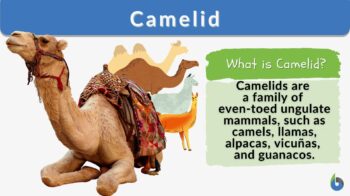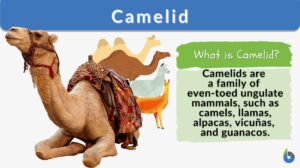
Camelid
n., plural: camelids
/ˈkæməlɪd/
Definition: Herbivorous, cud-chewing mammals with unique adaptations to arid environments
Table of Contents
Camelid Definition
A canelid refers to any of the even-toed ungulates of the family Camelidae, e.g. camels, llamas, alpacas, guanacos and vicuñas. These ungulates can be classified into two major groups: the Old World and the New World. The Old World camelids are the true camels such as the dromedary camels (dromedaries) and the Bactrian camels characterized by (1) their humps on their back and (2) the dulla, which is an organ found on the throat of male camels and is believed to be associated with the display of dominance among males and for attracting females. Most Bactrian camels are found in the arid and mountainous regions of Central Asia.
The South American camelids (New World camelids) include the modern llamas, alpacas, guanacos, and vicuñas. Wild populations of South American camelids, such as vicuñas, inhabit the high-altitude regions of the Andes Mountains.
General features of camelids
Camelids share several common features that define their biological characteristics.
- They are even-toed ungulates. These mammals are characterized by having soft-padded snowshoe-like feet where each foot has two toes.
- They have long necks and slender legs.
- Their upper lips are split into two independently mobile protrusions.
- These animals are herbivorous, primarily feeding on vegetation, and have a unique digestive system that allows them to extract nutrients from fibrous plant material. They are ruminants; but, not like other ruminants, the camelids have true canine teeth and tusk-like premolars. Their stomachs have three chambers in contrast to other ruminants that have four.
- One of the most recognizable traits is their ability to form herds.
CAMELIDS – Size Comparison | All Species (by RB Dahri World):
Biology definition:
Camelids are herbivorous, cud-chewing mammals belonging to the Camelidae family. The group includes the two-humped Bactrian camels, the single-humped dromedary camels, llamas, alpacas, and vicuñas. They are known for their remarkable adaptations to arid and high-altitude environments. Camelids are characterized by their long, slender necks and legs with padded feet. Camels are recognized for the distinctive hump on the back although this feature is not found in other camelids, such as llamas and alpacas. These herbivorous animals are well-suited for desert life, with the ability to store fat in their humps and conserve water efficiently. Their distinctive features allow them to thrive in various ecological niches, especially in the arid deserts of the Middle East and Central Asia, or the high-altitude regions of South America.
Etymology: The word “Camelid” is derived from the Latin word “Camelus,” which originally referred to camels.
Morphology And Adaptations
Here are some important morphological adaptations that enable camelids to thrive in arid environments.
- Hump: This is one of the most prominent features of the Old World camelids. The hum serves as a fat reservoir storing substantial amounts of energy that they can later metabolize. With it, the camels are capable of surviving extended periods of food and water scarcity.
- Long, slender yet sturdy legs and padded feet: This limb structure enables camelids to traverse challenging terrains and cover long distances, which is valuable for domestic camelids that can walk on various terrains for longer periods while carrying heavy loads. Thus, they served as “pack animals” for centuries.
- Limited sweat production: Camelids have a limited capacity to sweat, thus, preventing rapid dehydration in deserts or arid environments.
- Specialized respiratory system: They also have a specialized respiratory system. Before they exhale the air, the mucous membrane in their nasal passages reabsorbs moisture from it and then redirects the moisture back into their circulatory system, thus, preventing water loss.
- Water-efficient urinary system: They produce highly concentrated urine, which helps conserve water by reducing the amount of fluid expelled from their bodies.
Taxonomy And Evolution
The family Camelidae encompasses all living species of camelids. It is divided into two groups, the Old World camels and the South American camelids, each with its distinct evolutionary lineage. Despite their differences, both Old World and South American camelids have evolved in response to similar environmental challenges, demonstrating convergent evolution.
This family’s taxonomy reflects the unique biological diversity of these animals and their shared ancestry dating millions of years ago. Camelids are believed to have originated in North America millions of years ago. Over time, some camelid ancestors migrated to South America, which likely occurred through land bridges that once connected the two lands. Fossil records reveal the presence of ancestral camelids in both the Old World and South America, suggesting that these animals diverged from a common ancestor and evolved separately in response to their specific environments.
Scientific classification:
- Kingdom: Animalia
- Phylum: Chordata
- Class: Mammalia
- Order: Artiodactyla
- Suborder: Tylopoda
- Family: Camelidae Gray, 1821
Examples of Camelids
Here are four extant species as examples of camelids representing the family Camelidae, each with its own distribution:
- Dromedary Camel: Found primarily in Northern Africa and the Middle East.
- Bactrian Camel: Native to Central Asia
- Llamas: Domesticated camelid species, primarily found in South America.
- Alpacas and Vicuñas: Native to South America, particularly the high-altitude regions of the Andes.
NOTE IT!
Interesting Facts about Camelid
- Camels have a unique ability to tolerate extreme heat and can drink large quantities of water in a short time. For instance, the Arabian camel, also known as the dromedary, can drink up to 40 gallons (151 liters) of water in one go, enabling it to survive in arid desert environments.
- Camelids have been domesticated for thousands of years and played crucial roles in the development of various civilizations, including the Silk Road trade. Domestic llamas and alpacas are known for their gentle disposition and are often used as pack animals in the Andes.
- The vicuñas, a wild camelid species, are hunted for their wool, which is highly prized as one of the finest and most expensive wools in the world. Closely related to vicuñas are the “alpaca vicuñas” or simply “alpacas” which have been domesticated for their wool.
References
- Myers, P. 2000. “Camelidae” (On-line), Animal Diversity Web. Accessed October 08, 2023 at https://animaldiversity.org/accounts/Camelidae/
- Franklin, W. L. (1982). Biology, ecology, and relationship to man of the South American camelids. Mammalian Biology in South America, 6, 457-489. [Classic Reference]
- Burger, P. A., & den Outer, W. T. (2018). Camelid husbandry and pastoralism. In The International Encyclopedia of Biological Anthropology (pp. 1-4).
- The National Academies Press. (2007). The Biology of Camelids. [Classic Reference]
- Marín, J. C., Romero, K., Rivera, R., Johnson, W. E., & González, B. A. (2017). Conservation genomics of the wild relatives of the llama and the alpaca. Molecular ecology, 26(24), 7138-7154.
©BiologyOnline.com. Content provided and moderated by Biology Online Editors.







